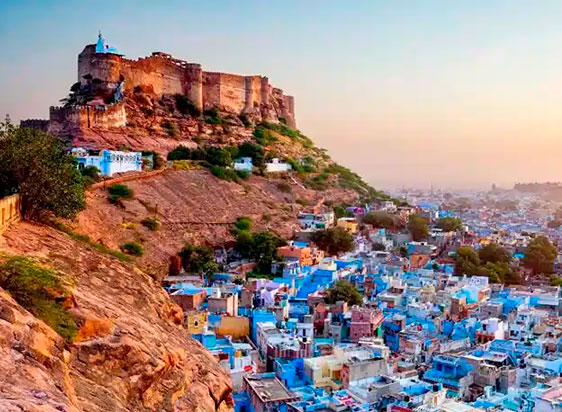
The lively atmosphere of Jodhpur, Rajasthan, is famously referred to as the Blue City, due to its unique indigo-colored houses that contrast with the arid landscape of the Thar Desert. Once the capital of the ruling principality of Marwar, Jodhpur was founded by Rajput leader Rao Jodha in 1459. Due to its strategic position on the ancient trade route connecting Gujarat and Delhi, Jodhpur was a thriving commercial center and has left behind the bountiful legacy of stunning temples, extravagant palaces and grand forts. Jodhpur offers a seductive blend of modern vibrancy and historical richness. Jodhpur is a visual retreat to everyone because of its colours, history and warm hospitality.
Mehrangarh Fort –
One of India’s largest and most magnificent forts, the undisputed gem of Jodhpur and lies on a hill that is 410 feet above. Built by Rao Jodha in 1459, this grand citadel stands over the Blue City and provides breathtaking rolling views from its ramparts. Various beautifully decorated palaces like the Moti Mahal, Phool Mahal, and Sheesh Mahal are surrounded by the huge walls of the fort. Each of the palaces is adorned with intricate carvings, paintings, and beautiful stained glass.
Jaswant Thada –
A serene and exquisitely sculpted white marble cenotaph was built in 1899 by Maharaja Sardar Singh in memory of his father, Maharaja Jaswant Singh II and is located close to Mehrangarh Fort. The Taj Mahal of Marwar is characterised by its rich domes, shiny marble that shines in the sunlight and intricate lattice screens. The Rathore monarchs are illustrated in grand portraits on the central memorial.
Umaid Bhawan Palace –
A historic hotel and royal residence, it was one of the largest private palaces in the world. Umaid Bhawan Palace is a breathtaking representation of Western Art Deco, Classical Revival and Indo-Saracenic. Initially built by Maharaja Umaid Singh in 1929 – 1943 to employ the starving people of Jodhpur. Today, the palace houses the reigning royal family, a luxury heritage hotel operated by Taj Hotels.
Ghanta Ghar –
The iconic Ghanta Ghar or Clock Tower lies around the bustling Sardar Market in the heart of the Old City. The huge structure was built by Maharaja Sardar Singh, a popular landmark and hub of activity. Sardar Market is a vibrant, maddening kaleidoscope of sight, sound and smell. Bargain for the authentic Rajasthani goods like spices, cloth, handicrafts, silver jewellery and colorful turbans, one of the best ways to experience local culture.
Mandore Gardens –
The heritage of the Ancient capital Mandore lies just 9 kms north of Jodhpur, the ancient capital of Marwar, before Jodhpur was founded. Jodhpur’s past Maharajas are found within a peaceful garden complex. Delicately carved, these multi-story red sandstone structures resemble temples rather than simple memorials. The Hall of Heroes has a lot of Rajput heroes and gods carved from a single piece of rock, and the cenotaph of Maharaja Ajit Singh.
Toorji ka Jhalra –
The stepwell of Kings, Toorji ka Jhalra, is a stunningly designed 18th-century stepwell in the ancient city that has only been restored and is increasingly popular. The stepwell was built by Maharaja Abhay Singh’s wife, Queen Toorji, a brilliant example of the old water management skills practised in Rajasthan. It offers a fascinating architectural experience with its stunning geometric carvings and a series of elaborate steps leading down to the lake.
Rao Jodha Desert Rock Park –
The 72-hectare Rao Jodha Desert Rock Park is an ecological restoration project alongside Mehrangarh Fort. The park was established in 2006 to restore the rocky wasteland surrounding the fort’s original charm. It has well-maintained walking trails that showcase the unique native flora and fauna of the Thar Desert.
Kaylana Lake –
A serene Artificial Lake is a large artificial lake built by Pratap Singh in 1872 and is located around 8 kms west of Jodhpur. It was built as a water supply for the city, presently a popular picnic spot and serene retreat. Surrounded by hills, the lake is conducive to boating and bird watching, especially at migratory times of the year. Kaylana Lake is a wonderful venue where one can take a leisurely walk in the evening and feel the cool breeze.
Balsamand Lake & Palace –
Jodhpur’s water reservoir was sourced from artificial Balsamand Lake, built in 1159 AD. The majestic Balsamand Lake Palace, constructed in 1936 as the royal summer home, sits over the lake. Mango and pomegranate,e and other fruit tree orchards could be spotted in the large gardens of the palace. The peaceful lake and the lush vegetation around offer a peaceful setting, even if the palace is a hotel.
Bishnoi Village Safari –
A much-touted experience for anyone seeking to learn about Rajasthan’s rural life and cultural practices firsthand. Bishnoi people live in harmony with nature and are world-famous for their deep respect for nature and its creatures. A safari usually involves a visit to various Bishnoi villages, observing their traditional lifestyle, witnessing local crafts, such as block printing and pottery, and witnessing desert animals like chinkaras and blackbucks in their natural habitat.
Conclusion –
Jodhpur is a truly arresting experience for every traveller with its seductive blue structures and imposing Mehrangarh Fort. The city itself boasts an incredibly diverse range of attractions, from the architectural grandeur of its lakes.
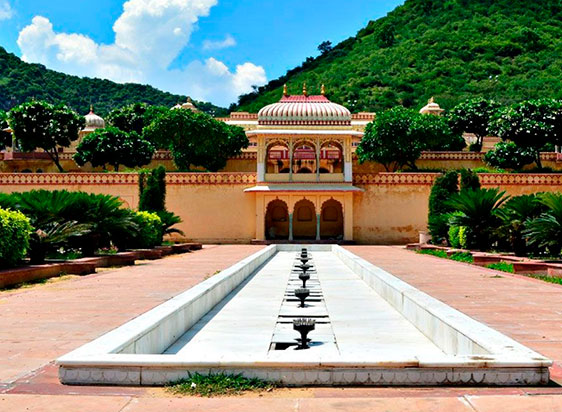
Sisodia Rani ka Bagh Jaipur
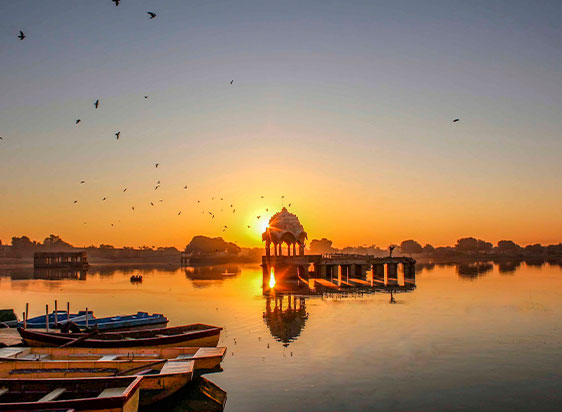
Gadsisar Lake Jaisalmer

Nathmal ji ki Haveli Jaisalmer
.webp)
Desert Festival Jaisalmer – Music, Dance & Culture
.webp)
Rajasthan Festival Calendar: Your Guide to Celebrations
.webp)
A Food Lover’s Guide to Rajasthan: What to Eat & Where
.webp)
Forts & Palaces of Rajasthan You Cannot Miss
.webp)
National Parks and Wildlife Sanctuaries in Rajasthan
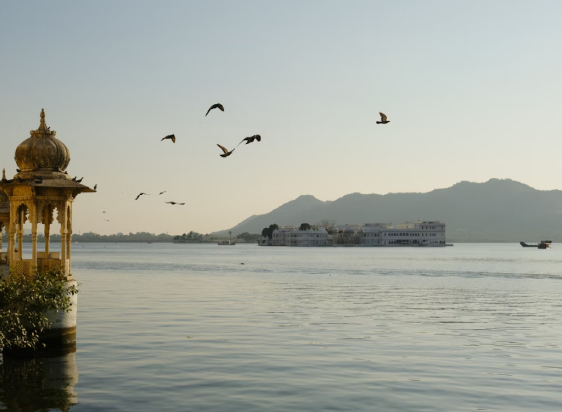
City Palace Udaipur Travel Guide: Timings, Tickets, History & Photography Spots
.webp)
Explore India’s Heritage in 3 Days: Golden Triangle Tour Itinerary
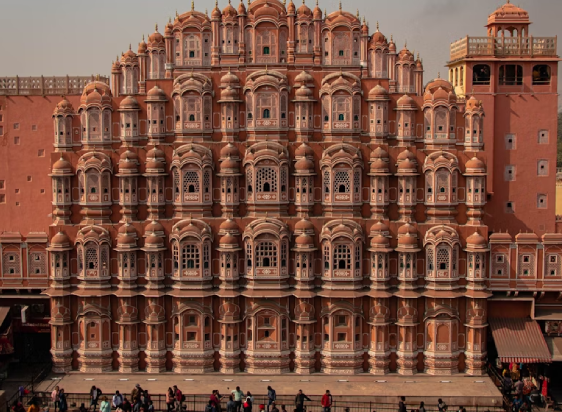
Golden Triangle Tour: 4 Days of History, Culture, and Adventure
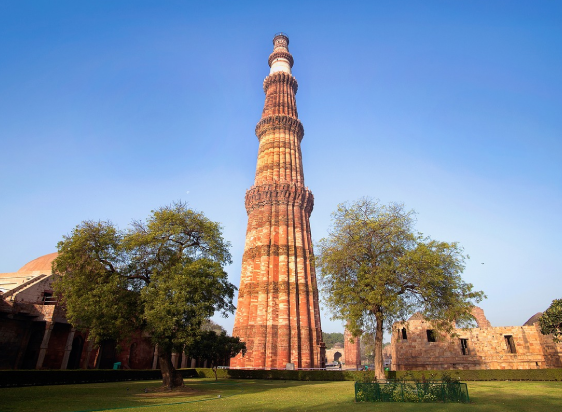
Maximize Your Experience: 5-Day Golden Triangle Tour Package Highlights
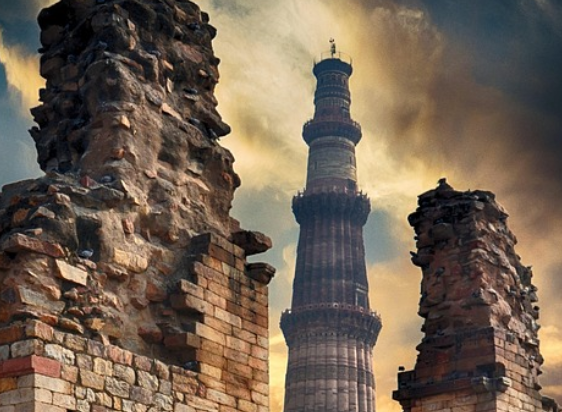
The Ultimate 6-Day Golden Triangle Tour: From Monuments to Markets
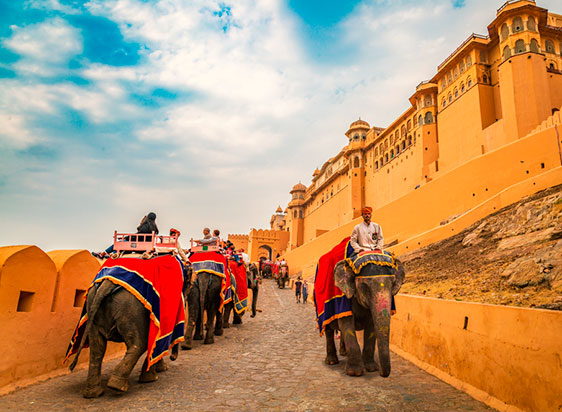
10 must-see places in Jaipur

10 must-see places in Jodhpur
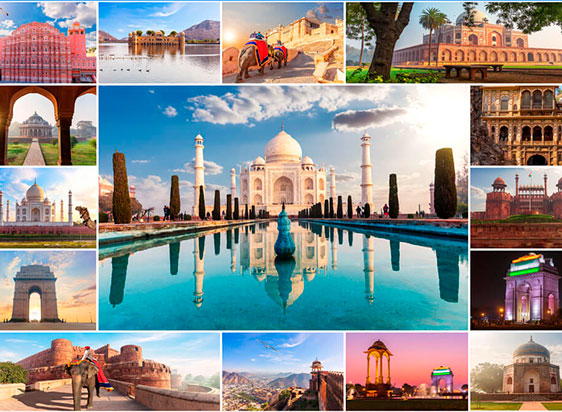
10 Must-See Places in India
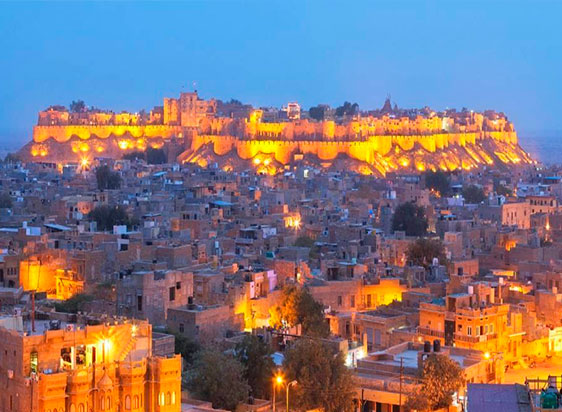
10 must-see places in Jaisalmer
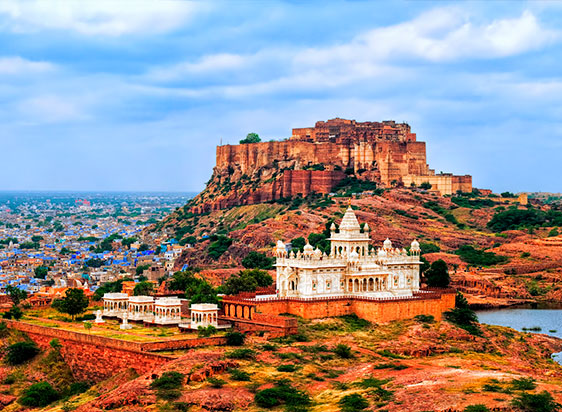
10 must-see places in Rajasthan
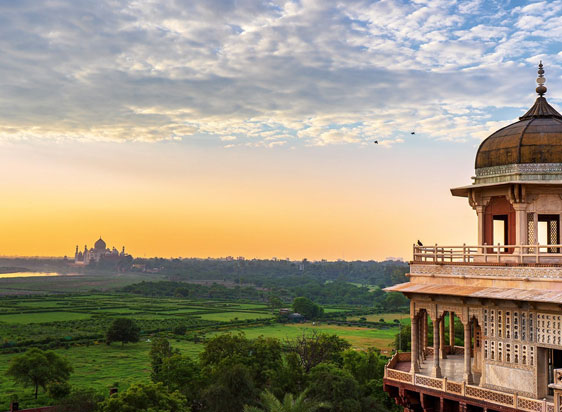
How to Reach Agra?
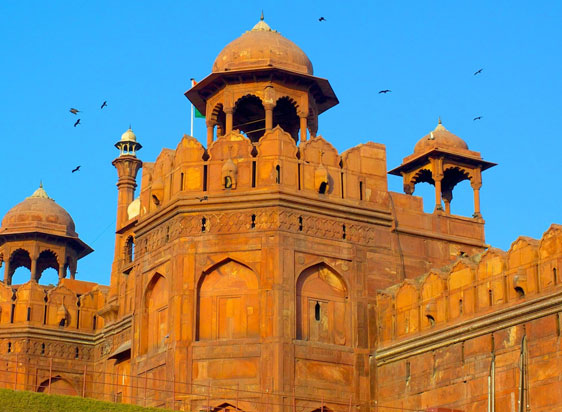
How to Reach Delhi?
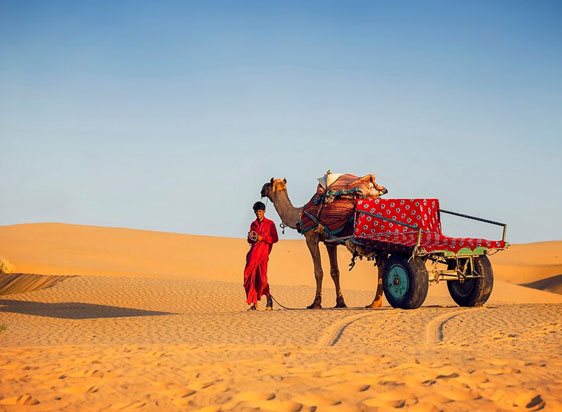
How to Reach Jaisalmer?
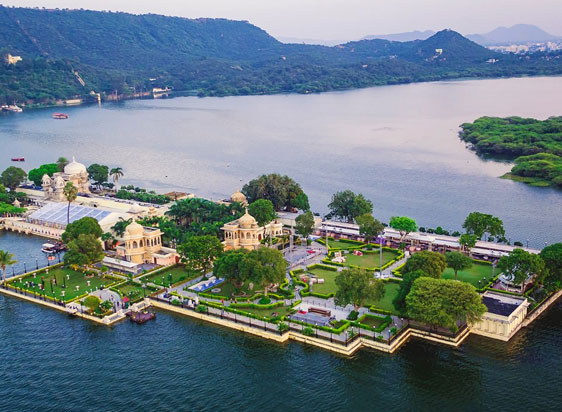
How to Reach Udaipur?
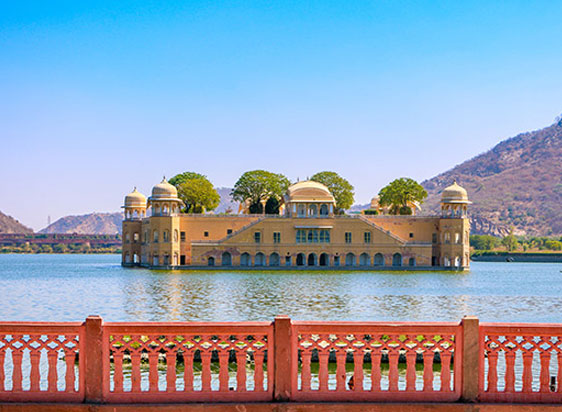
How to Reach Jaipur?

Char Dham Yatra: A Journey of Faith and Spiritual Awakening in Uttarakhand

Places To Visit in Jaipur with Family
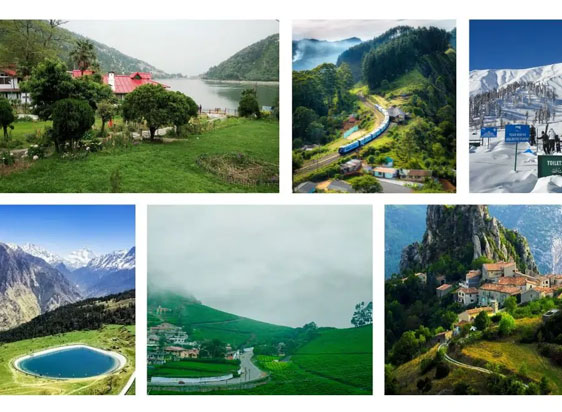
10 Hill Stations In India- Location, History, Timings, Images

India Gate Delhi – Location, History, Timings, Entry Fee, Images
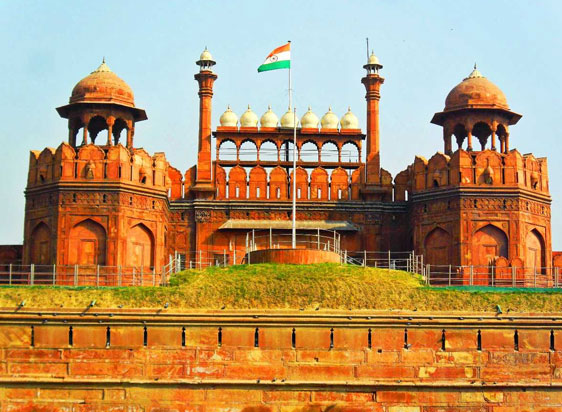
Red Fort – Old Delhi, Facts, Timings, History, Location

Golden Triangle Tour of Luxury and Budget-Friendly

Best Time to Visit the Golden Triangle: Seasonal Travel Guide

Akshardham Temple Delhi Timings, History, Entry Fee, Images, Aarti, Location & Phone Number

Best Ranthambore Tour Packages Itinerary

Best Jaisalmer Tour Packages Itinerary

Best Udaipur Tour Packages Itinerary

Best Jaipur Tour Packages Itinerary

Best Rajasthan Tour Packages Itinerary

How to pick the right India tour packages?

All India Tour Packages Cost: Exploring the Riches of Incredible India

Rajasthan Festivals Tour Guide

A Complete Travel Guide to Jaipur for IIFA 2025

IIFA 2025 Jaipur: Celebrating 25 Glorious Years of Indian Cinema / IIFA Awards 2025 Date, Venue, Tickets, Host, Transportation
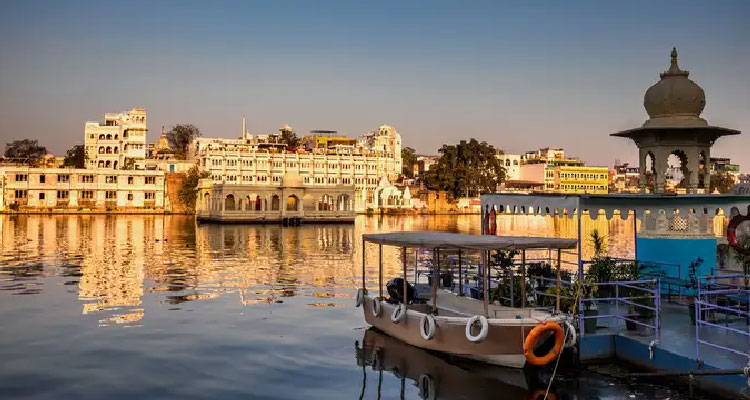
Taj Lake Palace Udaipur

Eklingji Temple, Udaipur

Bagore ki Haveli, Udaipur

Most Popular Dishes to Try in North India Tour

Ranthambore National Park Safari

Moti Doongri Ganesh Temple Jaipur
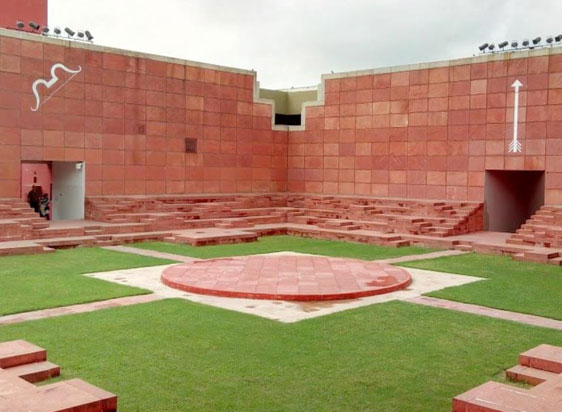
Jawahar Kala Kendra Jaipur
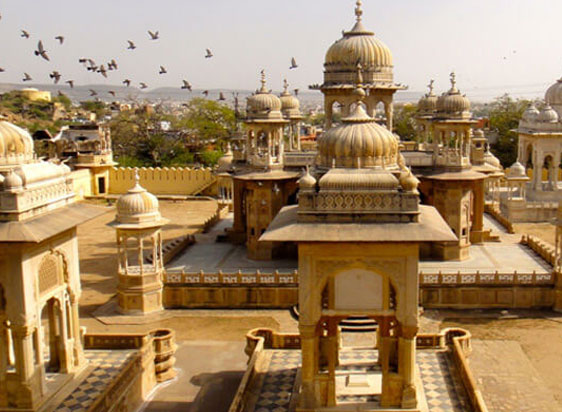
Gatore Ki Chhatriyan Jaipur – Entry Fee, Timing, Location

Albert Hall Museum Jaipur

Panna Meena ka Kund Jaipur
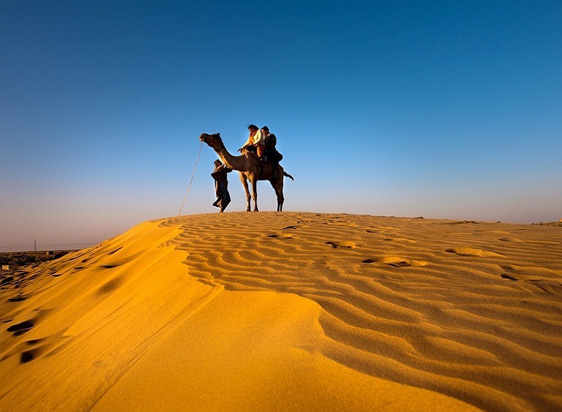
How to Book a Tour Guide in Jaisalmer?

How to Book a Tour Guide in Ajmer Pushkar?
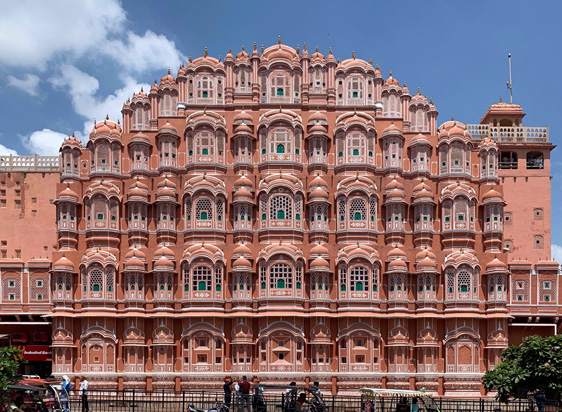
How to Book a Tour Guide in Jaipur?
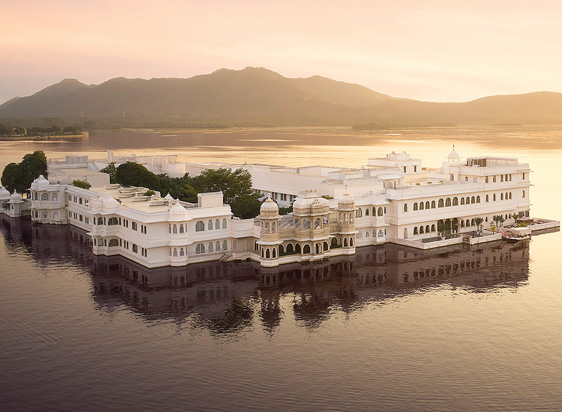
How to Book a Tour Guide in Udaipur?

How to Book a Tour Guide in Rajasthan?

Female tourist guide in Jaipur

Jaipur Solo Trip Package

These 7 spots will tell you why Rajasthan is the perfect spot for Glamping

7 Unforgettable Road Trips of Rajasthan

Film Shoot Locations in Jaipur

Jaipur Zoo Garden – Timings, Entry & Tickets Prices, and Things to See
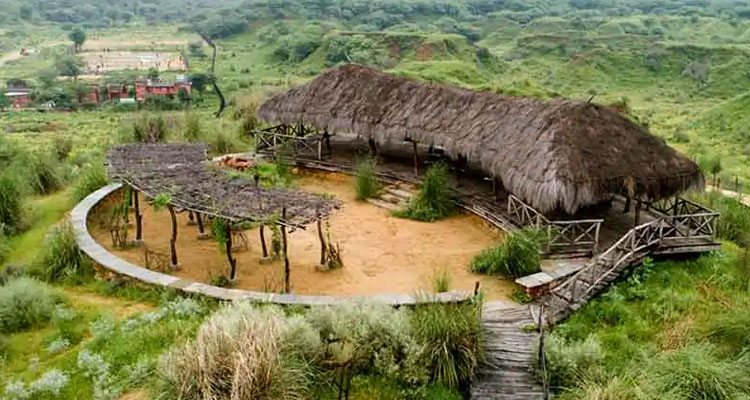
Kishan Bagh Jaipur – Entry Fee, Timings, Location
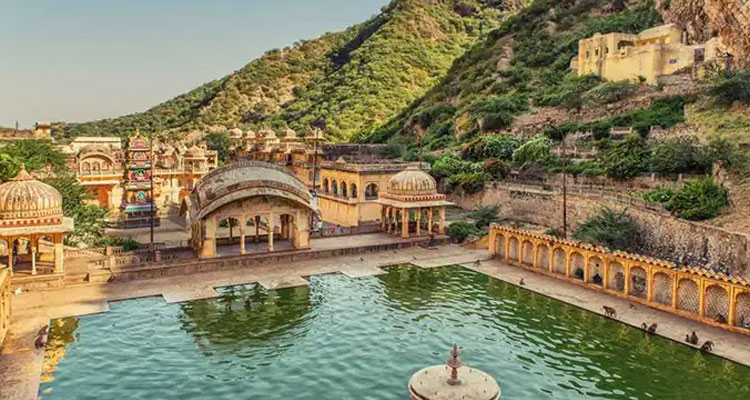
Jaipur Tourism: All you need to know
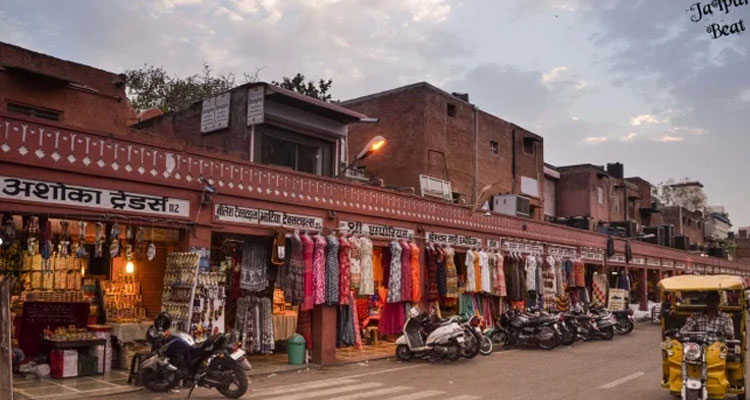
Johari Bazaar Jaipur: A Must-Visit Shopping Place

Chandra Mahal Jaipur

6 Exhilarating Road Trips From Jaipur That’ll Invoke Your Wanderlust Soul

Jaisalmer Nightlife: What To Do And See In The Golden City After Dusk Falls

Places To Visit in Udaipur At Night

Top 10 Winter Honeymoon Destinations in Rajasthan to Make Memories with Your Loved Ones

10 Best New Year Destinations in Rajasthan
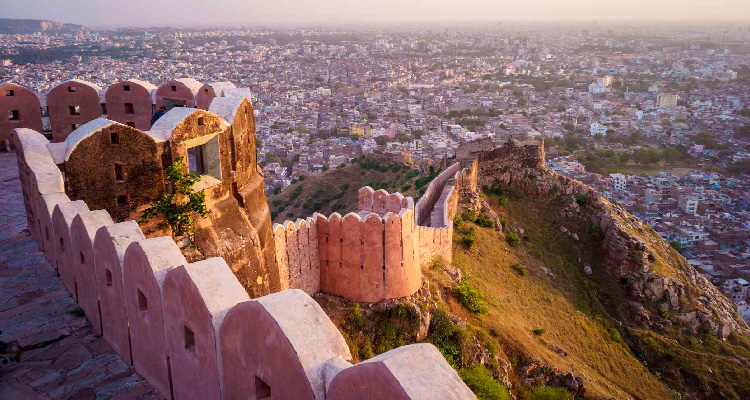
Nahargarh Fort Jaipur – History, Architecture, Timing, Entry Fee, Attractions, Lesser-Known Facts

Tips for Solo Female Travelers in Rajasthan

Discover the Unseen Places in Rajasthan

Best Monsoon Tour Packages of Rajasthan

12 Reasons Why I Absolutely Loved Rajasthan

Rajasthan Cultural Holidays

Best One Day Trips in Rajasthan

Birla Mandir Jaipur – History, Architecture, Timing, Entry Fee, Attractions, Lesser-Known Facts
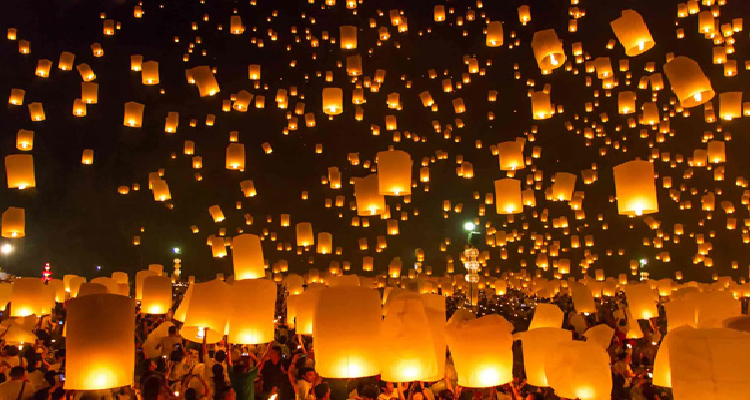
Top 7 Destinations in India to Celebrate New Year 2024

Jaipur Travel Tips
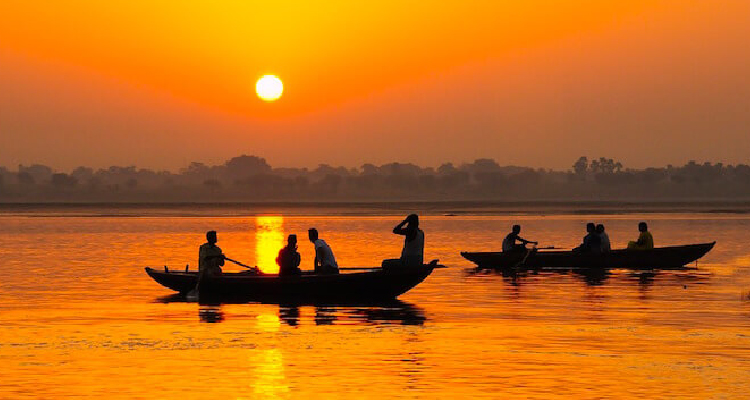
7 Amazing Things to Do and See in India in 2023-24
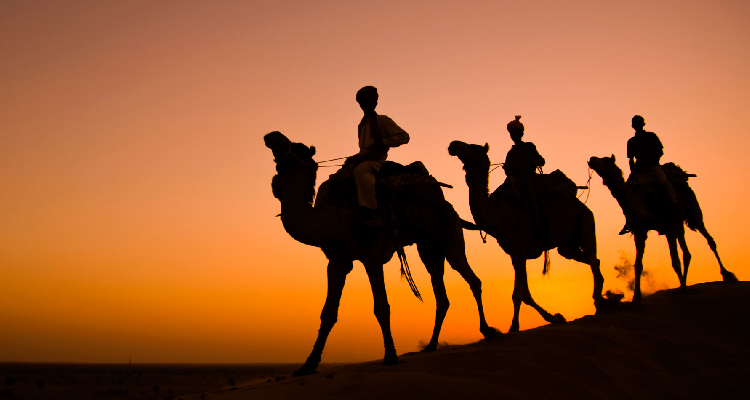
The Ideal Rajasthan Itinerary

Places to visit near Jaipur for 2 days

India's Top 10 UNESCO WORLD heritage sites

Royal Experiences in India to Make You Feel Like Maharajas in 2023-24
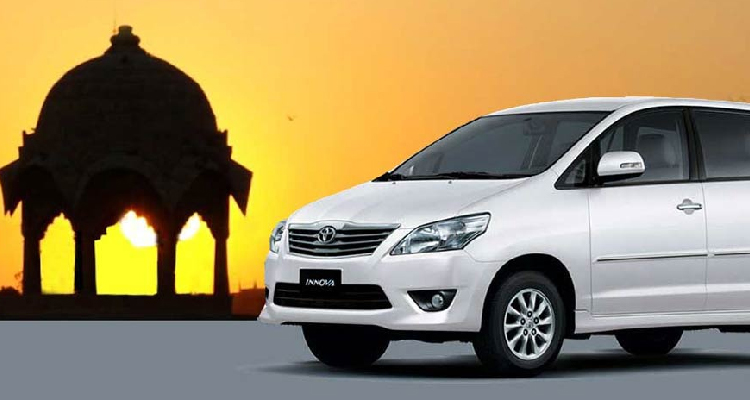
Jaipur Tour by Private Car and Driver

Luxury Travel India: Explore the best Luxury India Tour in one go
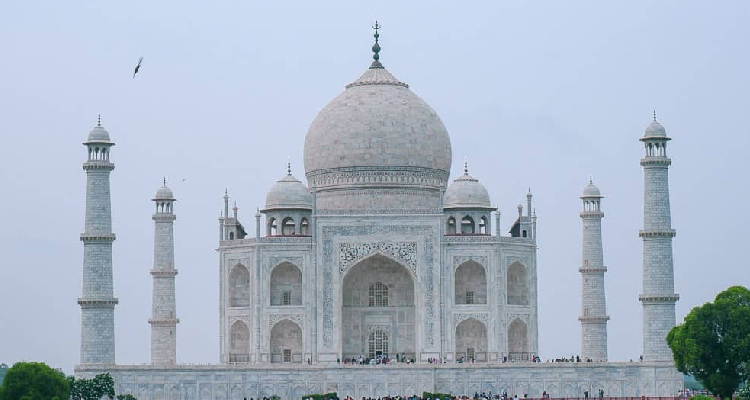
A Complete Guide to India Golden Triangle

How To Choose The Best Taxi Service in Jaipur for Sightseeing

The Ultimate Rajasthan Family Vacation: A Comprehensive Guide

Hawa Mahal: About, Time, History, Activities, Entry Fee

Chokhi Dhani Resort: About, Time, History, Activities, Entry Fee

JLF 2025: Jaipur Literature Festival, Dates, Lineup, Tickets
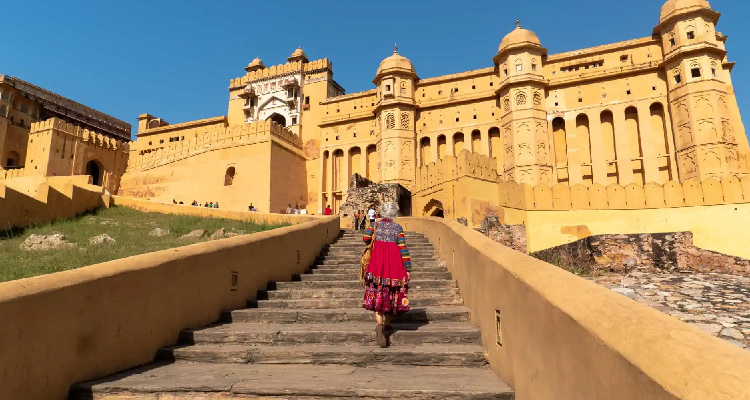
Planning a Rajasthan Family Adventure: Tips and Tricks

Jaipur Tour Guide
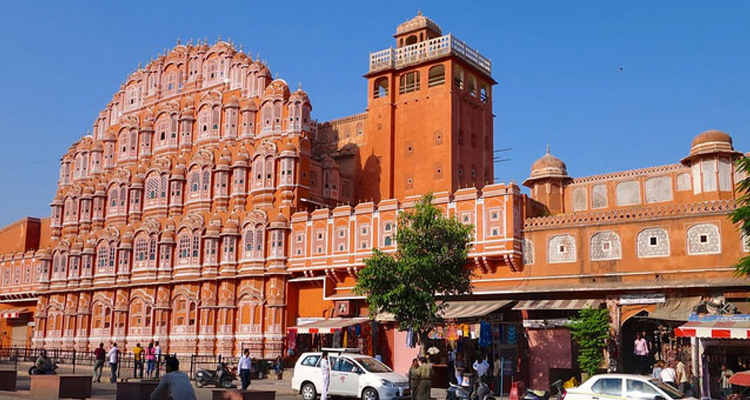
2 Days Jaipur Sightseeing Tour
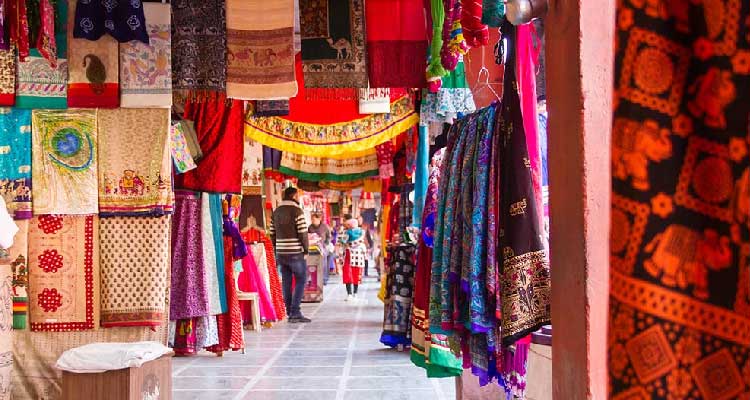
Shopping Paradise: A Guide to the Vibrant Bazaars of Jaipur

Discover Rajasthan with Kids: Top Family-Friendly Destinations

Luxury Cars in Jaipur for That Special Occasion

Top 10 Popular Temples To Visit In Jaipur
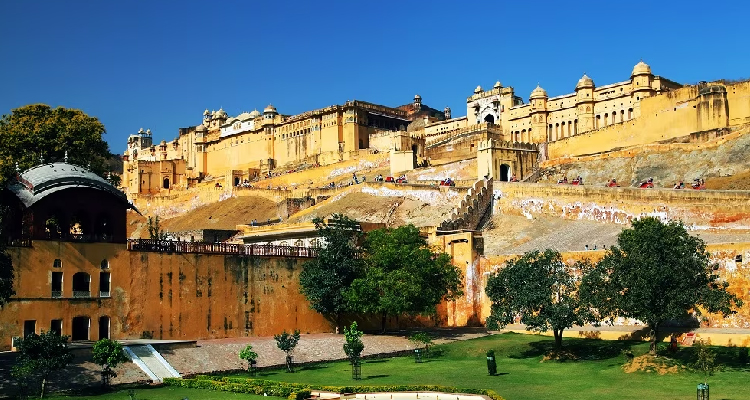
Rajasthan's Kid-Friendly Palaces and Forts: A Historical Adventure for the Family

Amber Fort: About, Time, History, Activities, Price

B2B Travel Company in Rajasthan
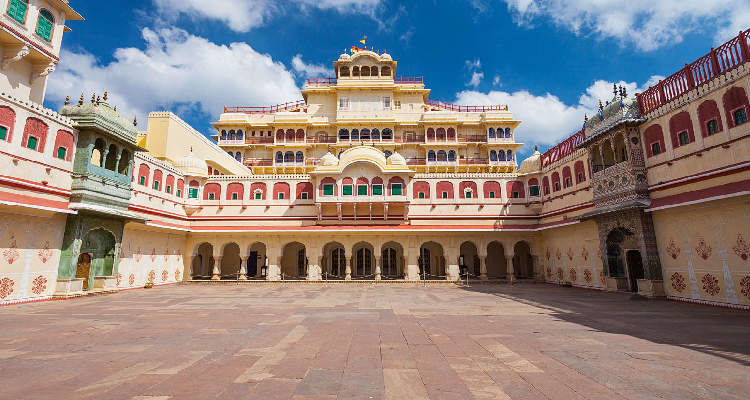
Unique Experiences to Enjoy in Jaipur

Family Fun in Jaipur: Exploring the Pink City with Children

Jaipur Shopping Guide: Best Things to buy and Shopping Places in Jaipur

Udaipur Unplugged: Family-Friendly Activities by the Lake
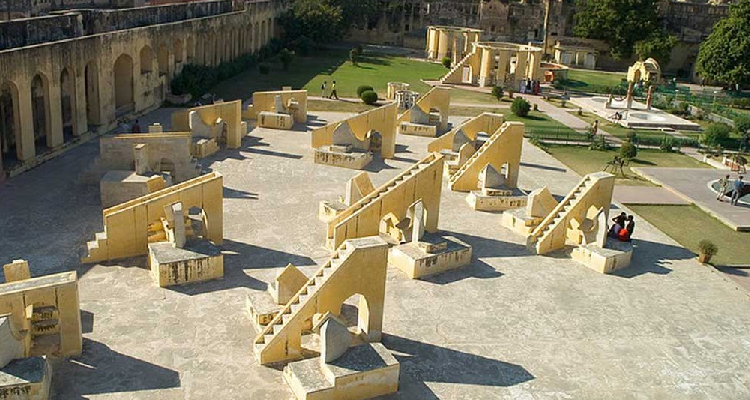
Jantar Mantar: About, History, Activities, Time, and Entry Fees

Wildlife Encounters in Rajasthan: A Family Safari in Ranthambore
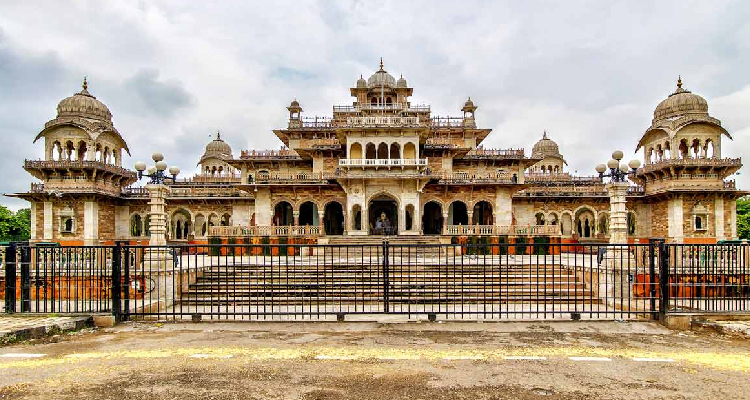
Albert Hall Museum: About, History, Activities, Time, and Entry Fee

Places to visit in Rajasthan

Top 7 Travel Destinations In Rajasthan For A Relaxing Trip In Winter 2022

Jaipur Food Tour

Rajasthan's Festivals for Families: Experiencing the Vibrant Culture Together

Jaipur Amber Fort: The Completer Tour Guide

Jaipur Tour By Tempo Traveller

Rajasthan's Royal Cuisine: Family Food Adventures

Exploring the Aravalli Hills: Family Trekking and Nature Walks

Amer Fort Light and Sound Show 2025

2 Days In Jaipur: Discover The Best Of Pink City In 48 Hrs

Hire Taxi in Jaipur

Jaipur Travel Guide: All You Need To Know For Planning Holiday in Jaipur
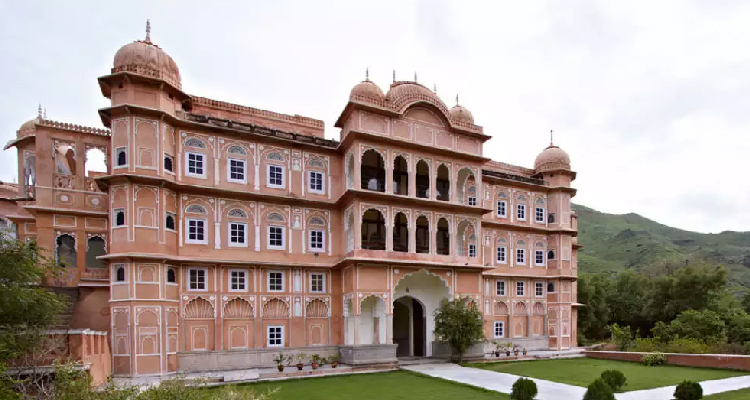
Heritage Hotels in Rajasthan: Unique Stays for the Whole Family
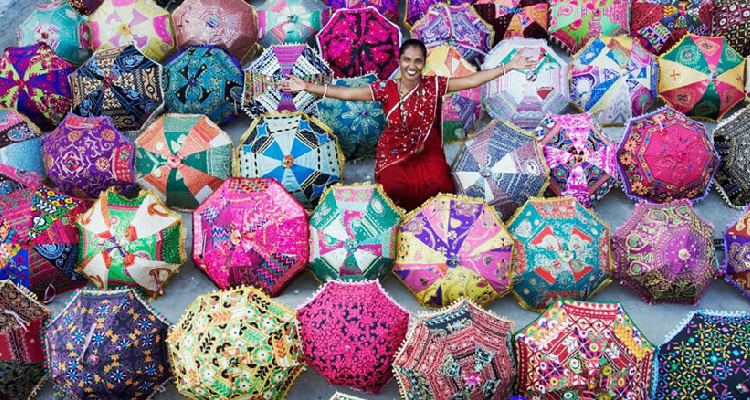
Crafting Memories: Family Art and Craft Experiences in Rajasthan

Wedding Car Rental in Jaipur

Top 10 Places to visit in Rajasthan in Winter
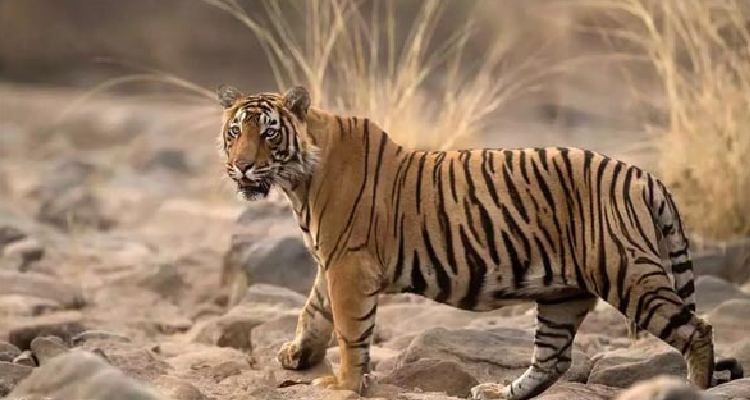
Discover These 5 Wildlife Sanctuaries Around Jaipur To Go On A Holiday Full Of Thrill!

Education Rajasthan Tour: An Ultimate Experience For Kids

Rajasthan Tour by Tempo Traveller

Hot Air Balloon Rides in Rajasthan: A Family Adventure in the Skies

Jaipur Airport Taxi
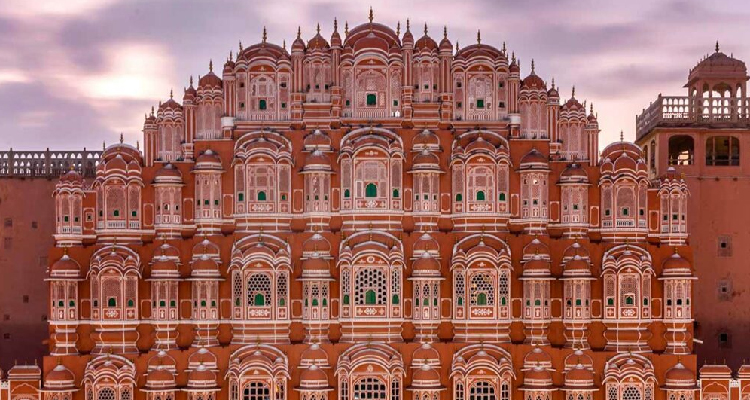
Golden Triangle Travel Guide
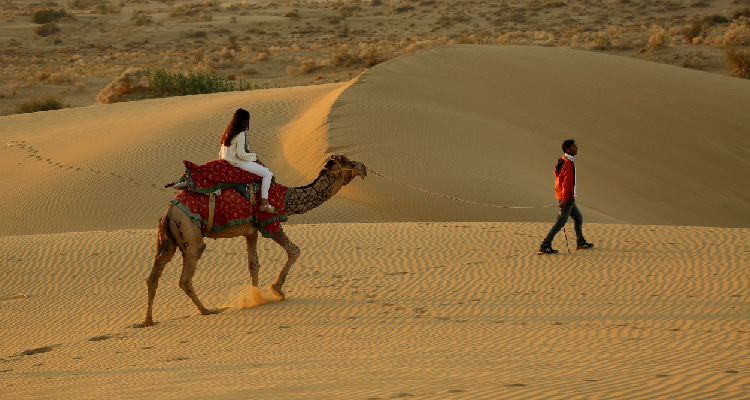
Camel Riding and Desert Camps: Family Adventures in the Thar Desert

Same-Day Tour to Jaipur

Shopping with the Family: Souvenirs and Local Markets in Rajasthan

7-Day Trip to Rajasthan
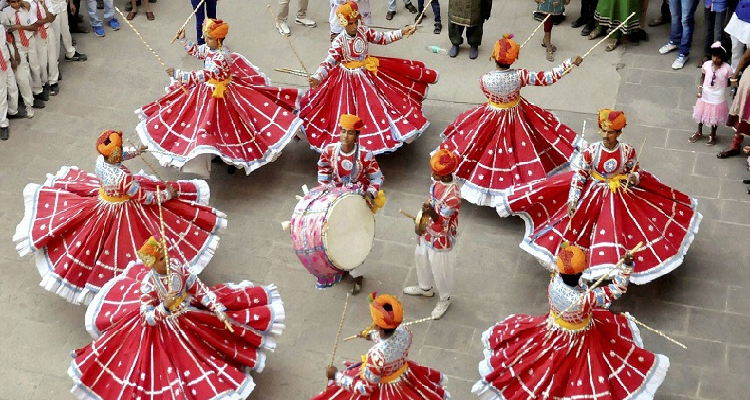
Festivals in Rajasthan

Rajasthan Luxury Tour by Car

Jaipur Like a Local: Experiencing the City Through Local Activities

Family Road Trip: Navigating Rajasthan's Scenic Routes

10 Luxury Stay in Rajasthan

Rajasthani Folk Tales: Storytelling Sessions for Children

Famous Foods of Rajasthan You Must Try on Your First Trip
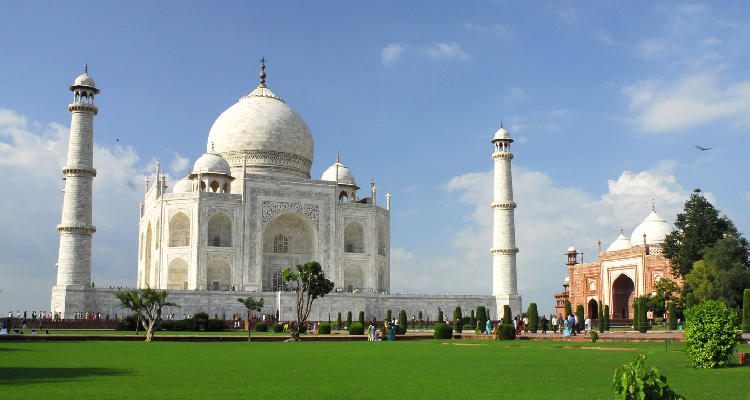
Places to visit On Golden Triangle Tour
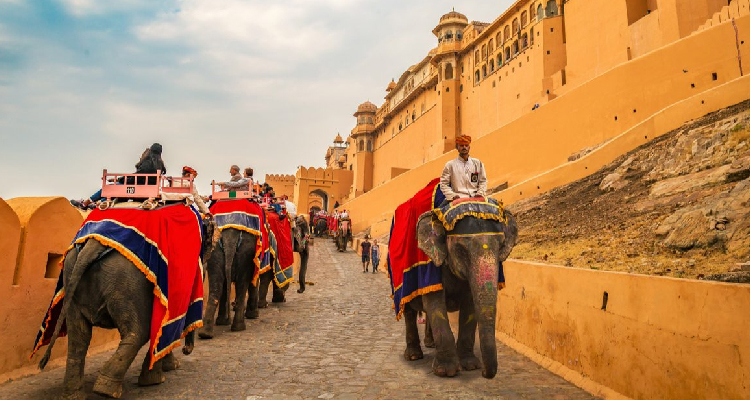
B2B Travel Company in Jaipur

How can I spend 3 days in Jaipur

How to Plan Your Rajasthan Tour

Jaipur Budget-Friendly Tour: The Best Way to Explore

Taxi in Jaipur

Unveiling the Pink City: A Historical Tour of Jaipur
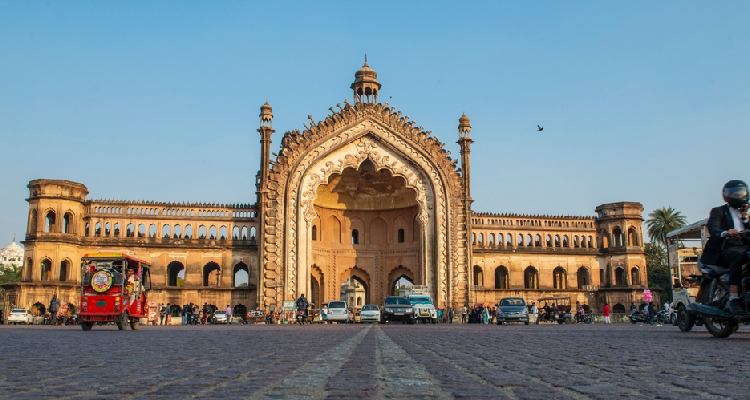
Places to visit in Ayodhya

Why is Jaipur known as Pink City

Taxi Services in Jaipur
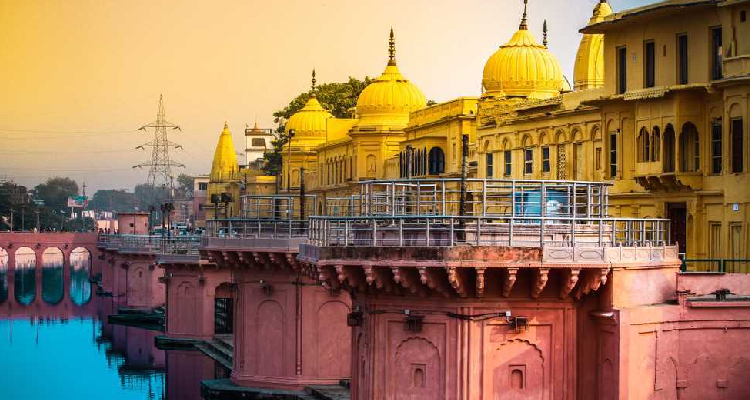
Places to visit near Ayodhya

Attractive Places to Visit Near Jaipur in One Day

Timing & fees for visiting Jaipur monuments
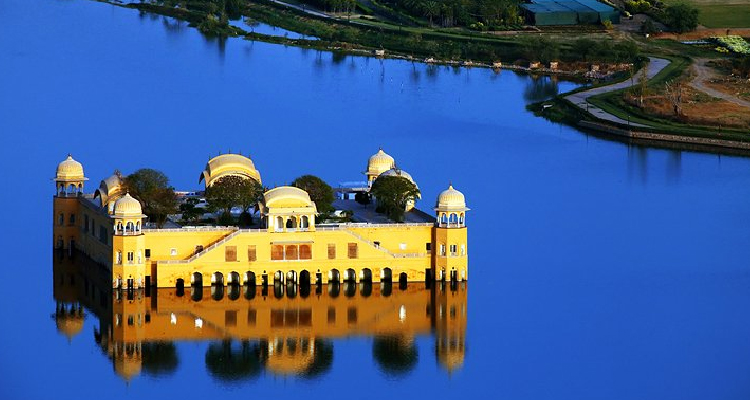
Places to Visit in Jaipur in Winters

Jaipur Sightseeing Tour

Ayodhya Shopping Guide
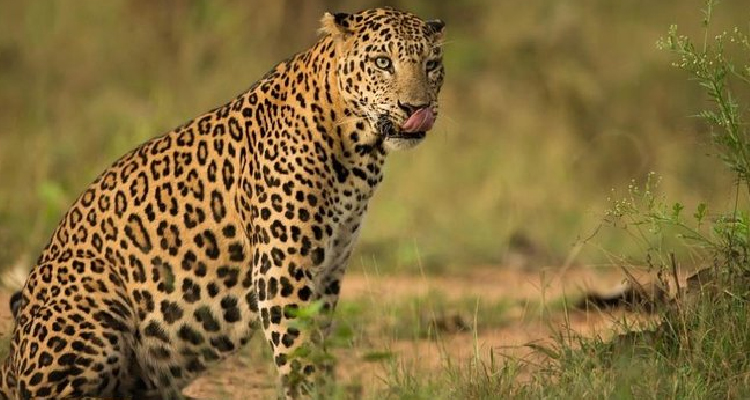
Jhalana Leopard Safari Price

Planning Your Golden Triangle Tour by Car
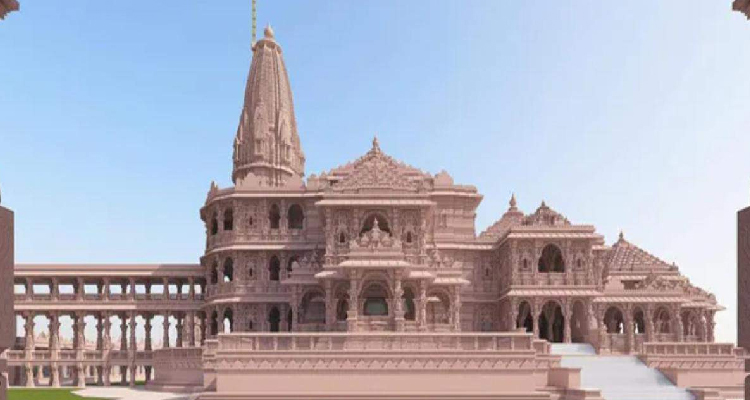
Ram Mandir Tour Guide (Ayodhya Tour Guide)
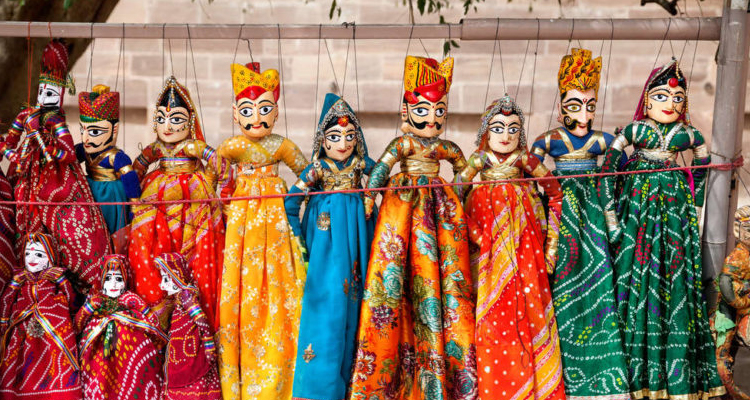
Rajasthan's Puppet Show and Folk Entertainment: A Delight for Kids

Jawai leopard Safari: Plan a memorable Wildlife Trip from Jaipur

Places to Visit Rajasthan in December
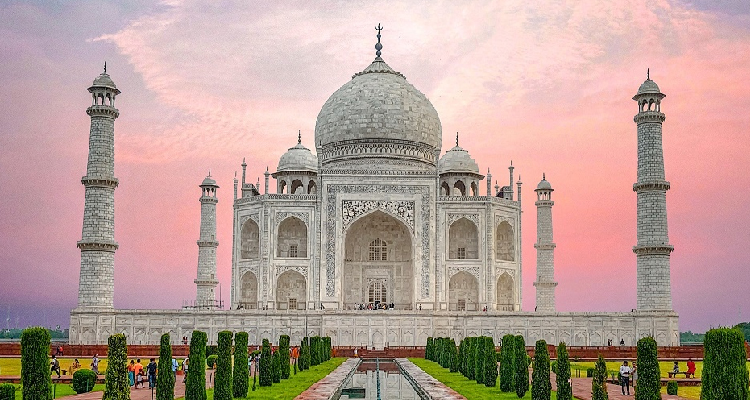
Taj Mahal Agra: Timings, History, Entry Fee, Images, Built by & Information
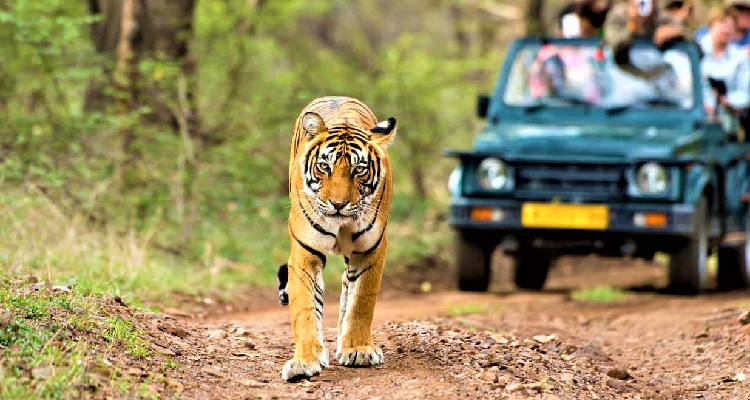
Best Wildlife Sanctuaries Around Jaipur

Tips to plan Jaipur Tour Packages
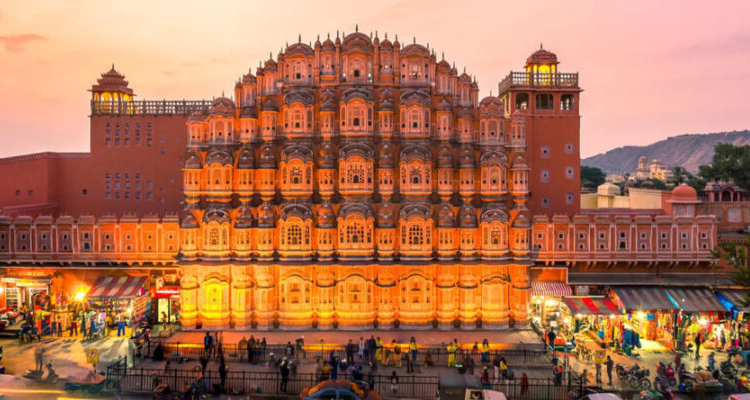
One Day Jaipur Local Sightseeing Tour Package by Car
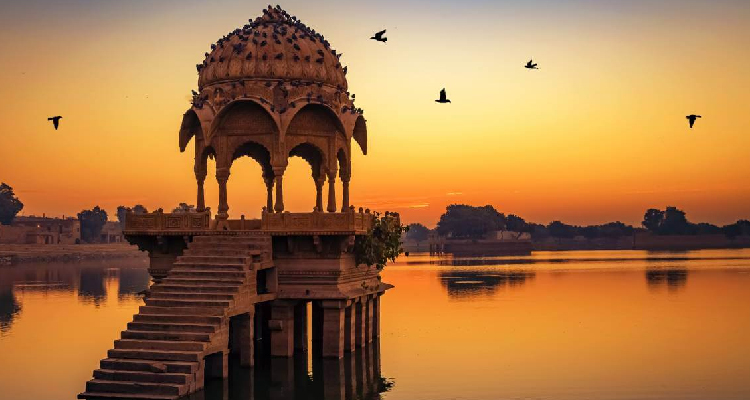
Most Popular Weekend Gateways From Jaipur

Chokhi Dhani Village Jaipur Package - Entry Fee, Timings 2023
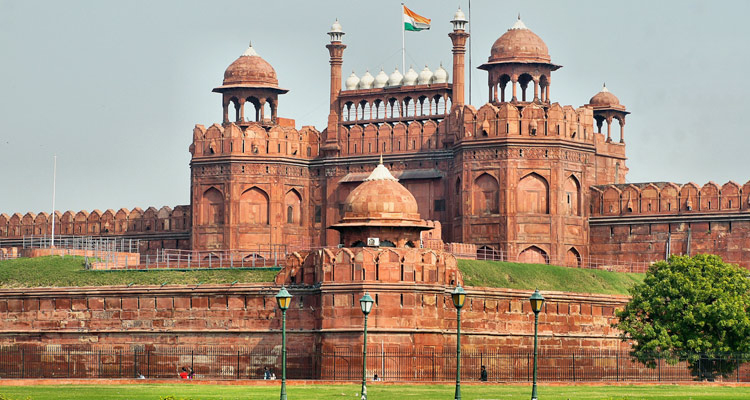
Red Fort / Lal Kila Delhi (Entry Fee, Timings, History, Built by, Images & Location
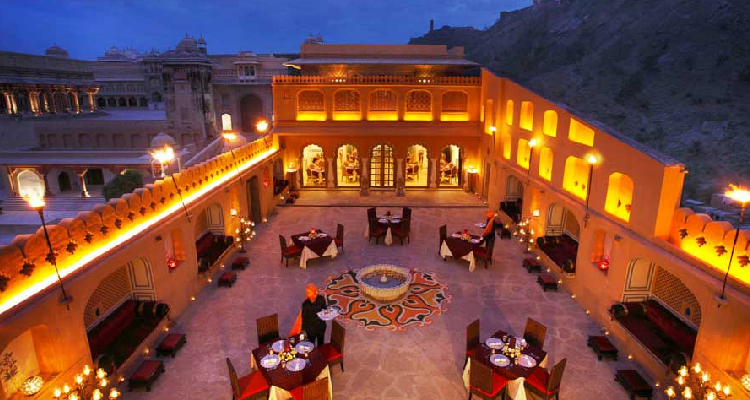
Best Honeymoon Destination in Rajasthan

10 Things To Do In Jaipur
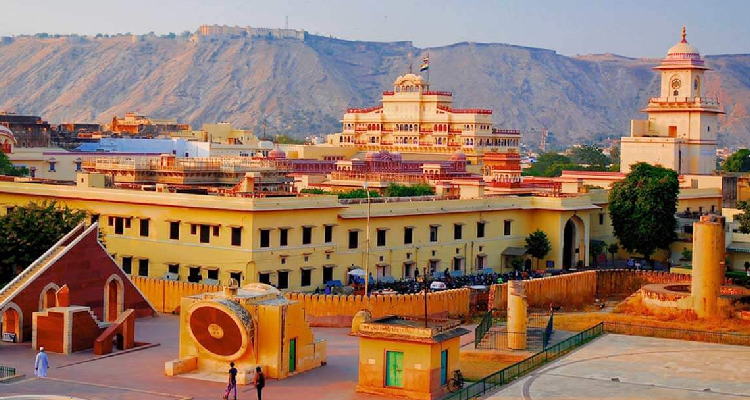
Rajasthan Travel Guide: Places to visit, Best time to visit, How to reach, etc.
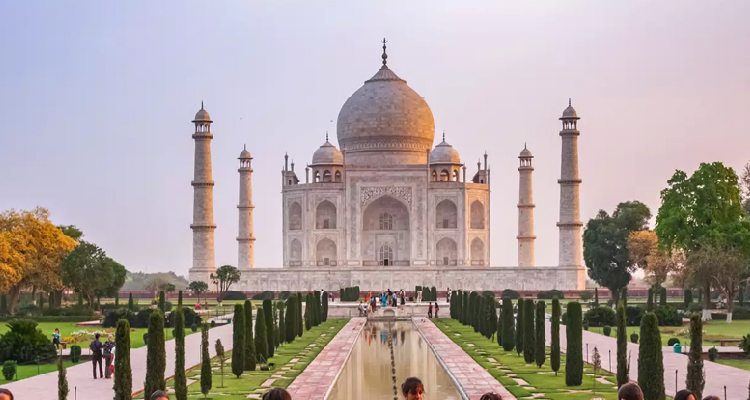
Jaipur Agra Same Day Tour
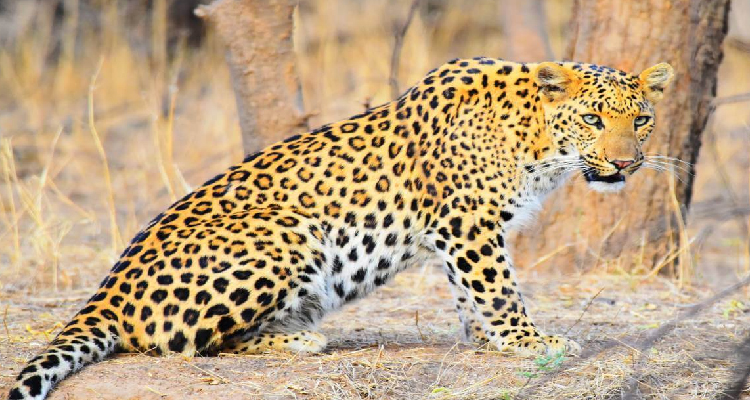
Best Time To Visit Jhalana Leopard Safari – Jaipur

Rajasthan Shopping Guide

7 Best Places To Visit Near Jaipur On A Same-Day Tour

How To Plan A Jaipur Trip?
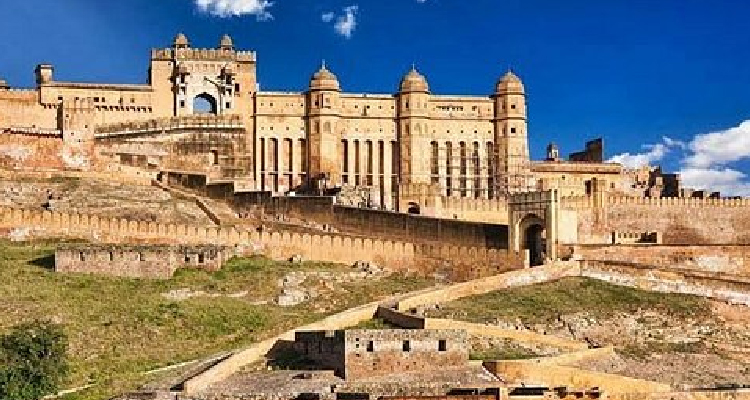
Top 68 Places to Visit in Jaipur
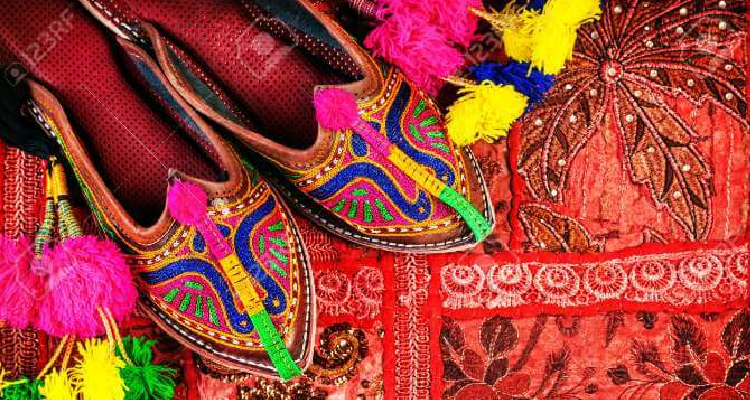
Best Shopping Places in Jaipur
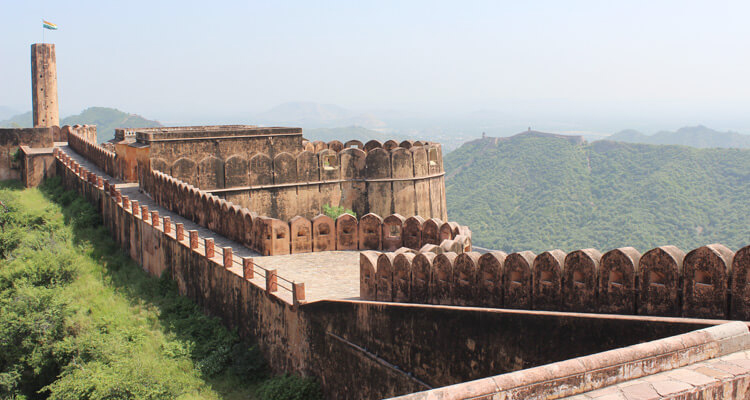
Jaigarh Fort, Jaipur (2024): Timings, Entry Fee, History
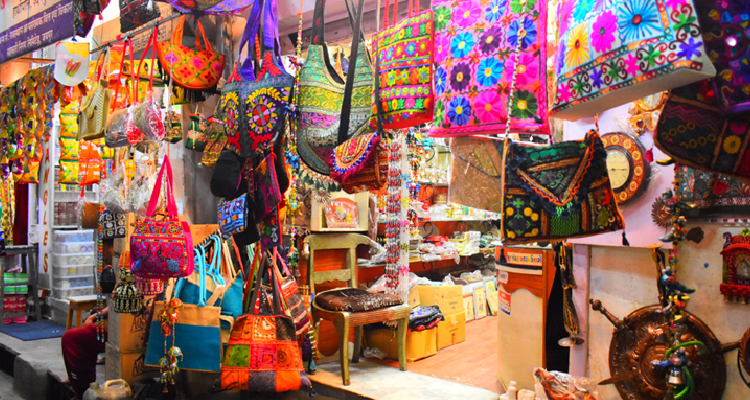
7 Things To Shop In The Jaipur Shopping Tour
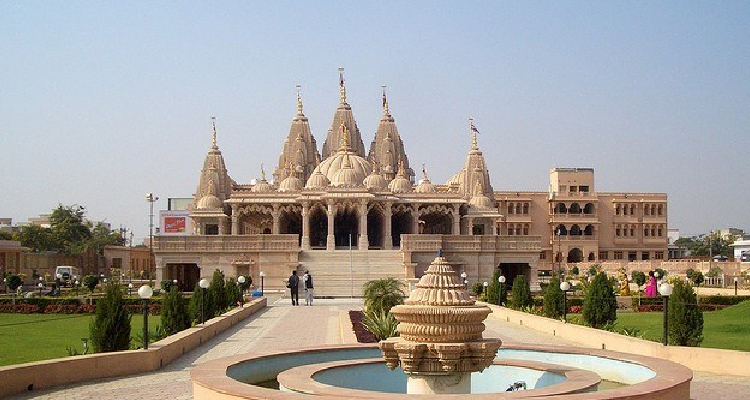
Akshardham Temple Jaipur

Luxury Car Rental in Jaipur
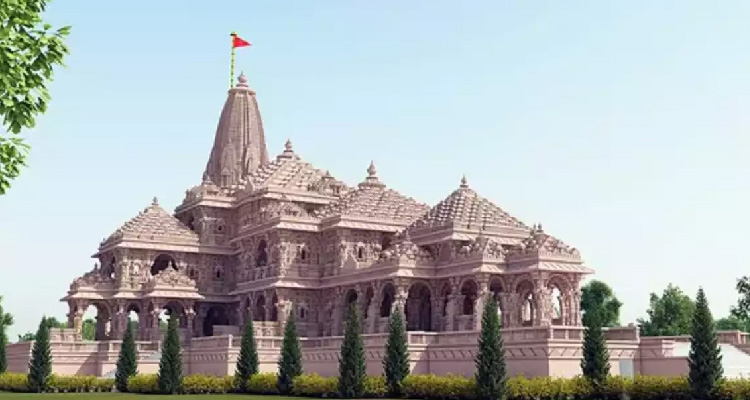
Architectural Marvels of Ayodhya: Heritage of Temples and Palaces

Planning Your Ayodhya Expedition: Travel Tips and Local Insights
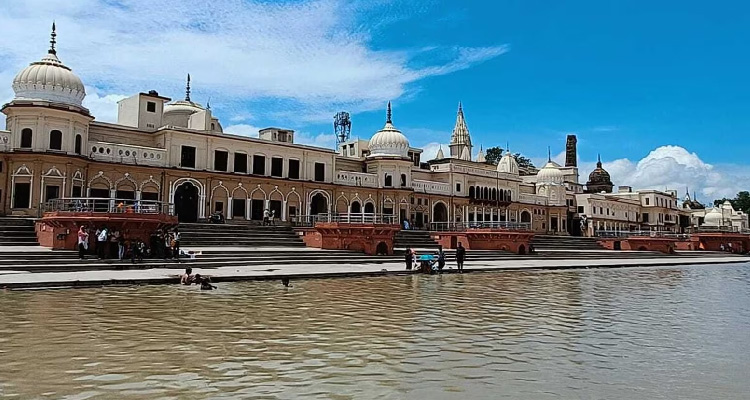
Heritage Walk: Unveiling Ayodhya's Historical Treasures
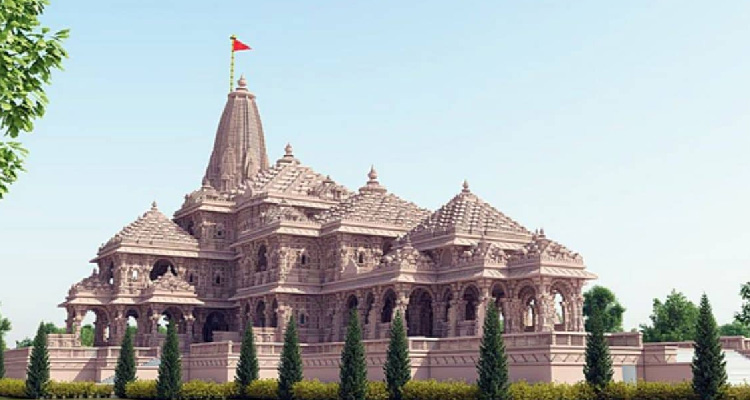
Exploring Ayodhya Beyond the Ram Mandir: Hidden Gems and Local Delights
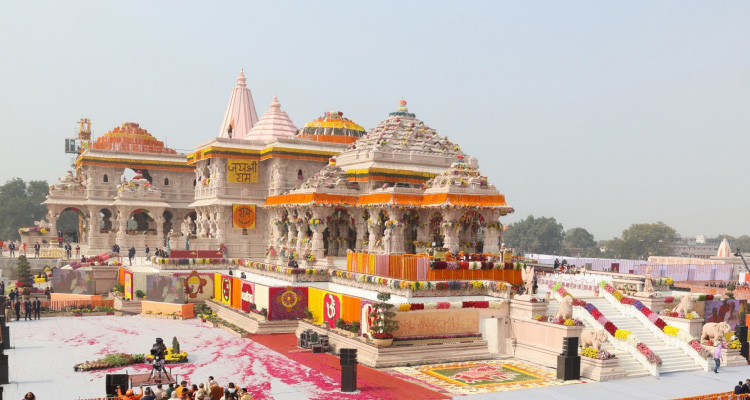
Things to do in Ayodhya

Call Our Customer Care Executive. We Are Available 24x7 Just Dial.
91-9166497735